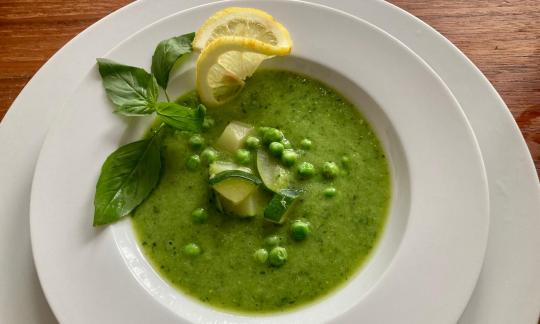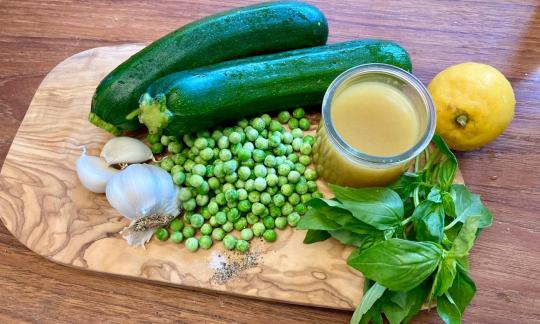Vegan zucchini soup with peas and basil without oil
vegan
Ingredients (for servings, )
| 5 cloves | Garlic (organic?) (0.53 oz) |
| 21 oz | Zucchini, raw, (organic?) |
| ½ | Lemons, raw (limes, organic?) (1.0 oz) |
| 18 oz | Vegan vegetable stock, organic? |
| 8 ½ oz | Peas, green, frozen, untreated (organic?) |
| ⅞ oz | Basil, fresh (organic?) |
| 1 dash | Table salt (table salt, raw?, organic?) (0.01 oz) |
| 1 dash | Black pepper (organic?, raw?) (0.00 oz) |
Equipment
- hand-held blender / immersion blender
- grater
- stove
- citrus juicer (lemon squeezer)
- saucepan
Type of preparation
- cook
- chop or grind
- squeeze
- sweat
- season to taste
- purée
- deglaze
- remove the skin
- grate (shred)
Preparation
Prepare ingredients
Peel the garlic and dice finely. Wash the zucchini, quarter it lengthways and cut into slices. Wash the lemon well and grate the peel of half a lemon.Make sure to use organic lemons, otherwise the peel will be heavily splattered.
The amount of zucchini for 4 portions corresponds to approx. 2 - 2 ½ medium-sized zucchini - so 4 starters or a main course for 2-3 people.
Preparation of the soup
Sauté the garlic in a pan with 1-2 tablespoons of water over medium heat. Add the zucchini, salt and pepper and stir. Sauté with the lid closed for about 3 minutes. Deglaze with the vegetable stock. Cook with the lid closed for another 7 minutes.Your own broth / stock: If you would like to prepare your own vegetable broth or vegetable stock, you will find suitable recipes below:
- Instant vegetable broth with carrots, celery and leek
- Vegan vegetable stock with celery, leek, fennelRemove the pot from the heat. Remove about a quarter of the zucchini and set aside. Add a small portion of the frozen peas to the zucchini that was set aside. Add the rest of the peas to the pot and let it simmer for about 1 minute. Add the basil and puree everything with a hand blender.
Season with salt, pepper and a dash of lemon.
Arranging and Serving
Add the reserved zucchini and peas to the pureed soup, heat briefly and then arrange on plates.Vary the consistency of the soup: For a clear soup, do not puree the ingredients. For a creamier soup, puree all ingredients.
|
Nutritional Information per person
Convert per 100g
|
2000 kcal | |
|---|---|---|
| Energy | 103 kcal | 5.1% |
| Fat/Lipids | 1.5 g | 2.2% |
| Saturated Fats | 0.24 g | 1.2% |
| Carbohydrates (inc.dietary fiber) | 19 g | 6.9% |
| Sugars | 8.3 g | 9.2% |
| Fiber | 5.5 g | 22.1% |
| Protein/Albumin | 6.1 g | 12.1% |
| Cooking Salt (Na:143.7 mg) | 365 mg | 15.2% |
| Essential micronutrients with the highest proportions | per person | 2000 kcal | |
|---|---|---|---|
| Vit | Vitamin K | 68 µg | 90.0% |
| Vit | Vitamin C (ascorbic acid) | 49 mg | 61.0% |
| Vit | Folate, as the active form of folic acid (née vitamin B9 and | 87 µg | 43.0% |
| Min | Manganese, Mn | 0.70 mg | 35.0% |
| Elem | Potassium, K | 634 mg | 32.0% |
| Vit | Vitamin B6 (pyridoxine) | 0.41 mg | 29.0% |
| Min | Copper, Cu | 0.23 mg | 23.0% |
| Vit | Thiamine (vitamin B1) | 0.26 mg | 23.0% |
| Prot | Threonine (Thr, T) | 0.20 g | 21.0% |
| Vit | Vitamin A, as RAE | 169 µg | 21.0% |
Detailed Nutritional Information per Person for this Recipe
The majority of the nutritional information comes from the USDA (US Department of Agriculture). This means that the information for natural products is often incomplete or only given within broader categories, whereas in most cases products made from these have more complete information displayed.
If we take flaxseed, for example, the important essential amino acid ALA (omega-3) is only included in an overarching category whereas for flaxseed oil ALA is listed specifically. In time, we will be able to change this, but it will require a lot of work. An “i” appears behind ingredients that have been adjusted and an explanation appears when you hover over this symbol.
For Erb Muesli, the original calculations resulted in 48 % of the daily requirement of ALA — but with the correction, we see that the muesli actually covers >100 % of the necessary recommendation for the omega-3 fatty acid ALA. Our goal is to eventually be able to compare the nutritional value of our recipes with those that are used in conventional western lifestyles.
| Essential fatty acids | per person | 2000 kcal |
|---|---|---|
| Alpha-Linolenic acid; ALA; 18:3 omega-3 | 0.20 g | 10.0% |
| Linoleic acid; LA; 18:2 omega-6 | 0.30 g | 3.0% |
| Essential amino acids | per person | 2000 kcal |
|---|---|---|
| Threonine (Thr, T) | 0.20 g | 21.0% |
| Tryptophan (Trp, W) | 0.05 g | 19.0% |
| Lysine (Lys, K) | 0.33 g | 18.0% |
| Isoleucine (Ile, I) | 0.21 g | 17.0% |
| Valine (Val, V) | 0.26 g | 16.0% |
| Leucine (Leu, L) | 0.34 g | 14.0% |
| Phenylalanine (Phe, F) | 0.21 g | 14.0% |
| Methionine (Met, M) | 0.08 g | 9.0% |
| Vitamins | per person | 2000 kcal |
|---|---|---|
| Vitamin K | 68 µg | 90.0% |
| Vitamin C (ascorbic acid) | 49 mg | 61.0% |
| Folate, as the active form of folic acid (née vitamin B9 and | 87 µg | 43.0% |
| Vitamin B6 (pyridoxine) | 0.41 mg | 29.0% |
| Thiamine (vitamin B1) | 0.26 mg | 23.0% |
| Vitamin A, as RAE | 169 µg | 21.0% |
| Riboflavin (vitamin B2) | 0.23 mg | 17.0% |
| Niacin (née vitamin B3) | 2.1 mg | 13.0% |
| Pantothenic acid (vitamin B5) | 0.79 mg | 13.0% |
| Biotin (ex vitamin B7, H) | 4.0 µg | 8.0% |
| Vitamin E, as a-TEs | 0.54 mg | 5.0% |
| Essential macroelements (macronutrients) | per person | 2000 kcal |
|---|---|---|
| Potassium, K | 634 mg | 32.0% |
| Phosphorus, P | 137 mg | 20.0% |
| Sodium, Na | 144 mg | 18.0% |
| Magnesium, Mg | 56 mg | 15.0% |
| Calcium, Ca | 77 mg | 10.0% |
| Essential trace elements (micronutrients) | per person | 2000 kcal |
|---|---|---|
| Manganese, Mn | 0.70 mg | 35.0% |
| Copper, Cu | 0.23 mg | 23.0% |
| Iron, Fe | 2.2 mg | 16.0% |
| Zinc, Zn | 1.2 mg | 12.0% |
| Selenium, Se | 2.3 µg | 4.0% |
| Fluorine, F | 65 µg | 2.0% |
| Iod, I (Jod, J) | 3.1 µg | 2.0% |
This vegan zucchini soup with peas and basil without oil is quick to prepare and healthy. It is suitable as a starter or main course.
Portion information: The specified amount of 4 portions is sufficient for 4 starters or a main course for 2-3 people.
Nutrient profile: One portion of this soup covers almost the entire daily requirement of vitamin K, which plays an important role in blood clotting and bone metabolism. Vitamin C is covered by over 50% and folic acid by over 40%. The ratio of omega-6 to omega-3 fatty acids is 2:1, well below the maximum recommended ratio of 5:1. More on this under: Vegans often eat unhealthily. Avoidable nutritional errors.
Zucchini: Zucchini is versatile in terms of its use (can also be eaten raw). In addition to the classic green zucchini, yellow zucchini is increasingly available. However, they taste almost identical. Zucchini is easy to digest, low in calories and rich in vitamins. Be careful with bitter-tasting zucchini. The bitter taste is caused by the poisonous bitter substances cucurbitacins. These cannot be destroyed by cooking and attack the stomach and intestinal mucosa. An increased content of bitter substances can arise, especially when grown at home (by backcrossing home-grown seeds or crossing with other pumpkin plants).
Peas: Green peas have a crunchy consistency and can be used in many different dishes. They can be eaten raw and are high in protein and carbohydrates.
Vegetable stock: A basic distinction is made between broth and stock. Broth serves both as a basic ingredient and as a dish in its own right, whereas stock is a heavily boiled, concentrated, salt-free, and therefore unfinished cooking ingredient. However, depending on the concentration, stock is a very intense flavor carrier. For health reasons, we deliberately choose the low-salt version.
Basil: Fresh basil is a popular spice in Mediterranean cuisine. The leaves are more aromatic raw (fresh) than cooked or dried. Basil, sometimes referred to as "German pepper", is ideal for saving on table salt thanks to its aromatic, peppery aroma.
Reduce salt and oil: We have consciously reduced salt and left out oil for health reasons. You can find more information on this topic in our book, which we describe in detail: "Salt Sugar Fat" by Michael Moss.
Buying stock: Stocks are available in every well-stocked supermarket, usually in jars. However, commercial stocks often already contain salt, which is something to keep in mind for further use.
To peel garlic more easily: Cut off the lower part of the clove. Now press the clove briefly and firmly with the handle of the knife so that it breaks open easily. The skin will now come off on its own.
Vary the consistency of the soup: For a clear soup, do not puree the ingredients. For a creamier soup, puree all ingredients.
Your own broth / stock: If you would like to prepare your own vegetable broth or vegetable stock, you will find suitable recipes below:
- Instant vegetable broth with carrots, celery and leek
- Vegan vegetable stock with celery, leek, fennel






